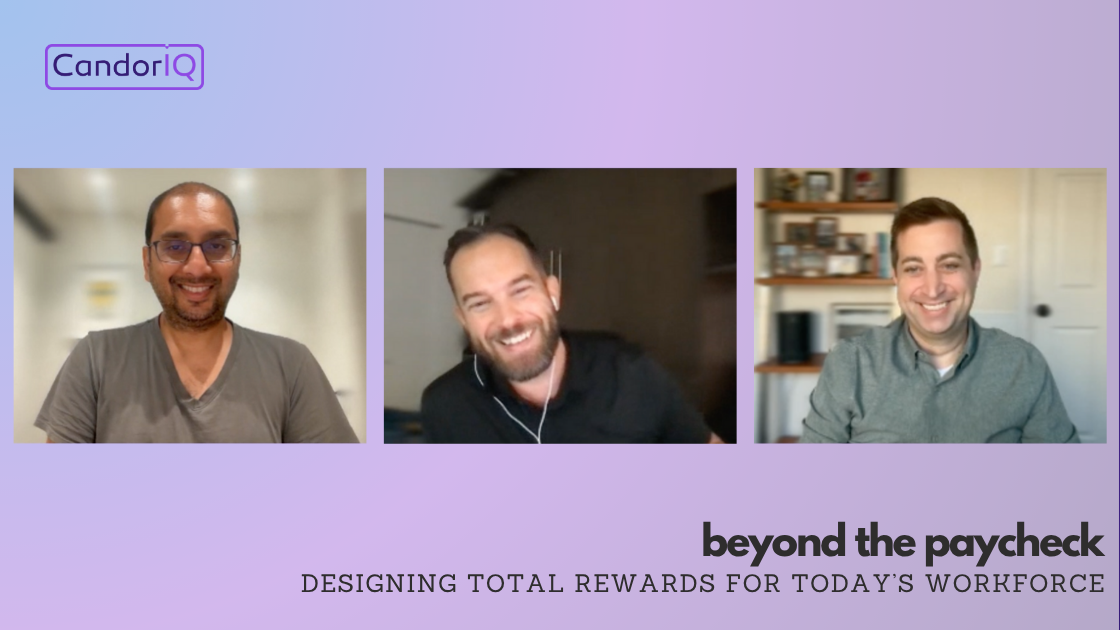Recap: Beyond the Paycheck, Designing Total Rewards for Today’s Workforce
Insights from Haris Ikram, Sean Raible, and Dave Carhart on evolving total rewards strategies, why pay alone isn’t enough, and how to design compensation, benefits, and perks that align with today’s workforce and business goals.

In a candid conversation on the evolving state of Total Rewards, Haris, Sean, and Dave unpacked why pay alone no longer sustains attraction and retention—and how leaders can design programs that are both human-centered and financially sound.
Beyond pay: what employees now expect
Dave opened with a clear baseline: “competitive pay is table stakes… you have to get it right,” but “it’s not enough to just get competitive pay right.” Employees know each job is a chapter, not the whole book; they evaluate development, future opportunities, and how a company “takes care of me” while they’re there. That’s driving demand for benefits, growth pathways, and flexibility that feel genuinely meaningful.
Sean spotlighted the mounting cost pressures and a renewed focus on mental health and wellness. He urged teams to apply a human-centered lens to design and execution: How does it actually feel when someone needs to use a benefit at a hard moment? Claims experiences, short-term disability handling, and EAP interactions can either reinforce care—or create stress and distrust—depending on how they’re administered.
Are rewards landing? Follow the signals
Haris called out an all-too-common gap: “A lot of benefits are unused… sometimes organizations are kind of checking the box… [and] not perfectly connecting the dots between what the business goals and objectives are.” Dave recommended evaluating programs through employee outcomes, business outcomes, and financial outcomes, and “draw[ing] from a range of signals… not just… the last article… or who is just shouting the loudest.” Surveys, focus groups, HRBP insight, and recruiting feedback together form a better picture of what actually resonates.
Personalization—without breaking fairness
On customization, Dave cautioned against offering choice in the wrong places. Cash and equity need consistent, rigorous structures to maintain fairness and trust. Instead, personalize the career journey: help people understand how roles, performance, and progression tie to compensation (e.g., moving from engineer to senior engineer). That clarity empowers employees to make informed choices without destabilizing pay architecture.
Sean shared two helpful lenses for design. First, think holistically across rewards, opportunity, leadership, and environment—and make each piece intentional. Second, search for the “sweet spot” among market dynamics, business strategy/affordability, and employee voice. You won’t please everyone, but you can tune programs to where they matter most—and keep tuning as conditions change.

Flexibility, RTO, and the retention equation
Return-to-office remains a hot button. Dave’s advice: “the most important thing is to make a clear decision that you align the leadership around and that you’re willing to stand behind.” He sees strong logic in organized hybrid, yet “there is… space in the market for another set of companies to hold really fast to a fully virtual strategy” and capture talent leaving office-first firms. Wherever you land, align comp and benefits to support the model, and ensure there’s a compelling reason to be in-office if that’s your path.
Measure what matters—and mind the money
Measurement starts with utilization data, complemented by listening mechanisms (focus groups, interviews, pulse surveys) that often double as education moments—many employees discover offerings they didn’t know existed. Be intentional in benchmarking choices, define where you want to sit in the market by element, and visualize over/under-investment across the portfolio. And don’t overlook procurement hygiene: “Please talk to your benefit broker. Understand your fee agreement…” to avoid leaving dollars on the table.
Communication is the force multiplier
Rewards only work if people understand and use them. As Haris summarized, “having great comp and benefits gets you so far, but you need to make sure employees understand those, appreciate them, and leverage them.” Managers play a pivotal role—“Managers are the messengers in so many cases,” Dave noted—so equip them to explain the philosophy and the mix. Modern content tools (including AI) make it easier to spin up FAQs and multimedia explainers fast; pair that with employee-generated content and creative campaigns to boost engagement.
HR–Finance partnership: design for sustainability
Budget realities are inescapable, which is why Dave emphasized, “It starts with partnership.” Build a tight relationship with Finance to model trade-offs, align on cost and intent across categories, and advise leaders with a shared, rigorous view. That trust enables smarter scenario planning—and rewards decisions that are generous where they matter and sustainable over time.
Final takeaways
- Pay is necessary but insufficient; design holistic, human-centered rewards.
- Use multiple signals to assess impact; don’t chase the “hot new thing.”
- Personalize careers (clarity and progression) while keeping comp structures fair.
- Make a clear RTO decision and align rewards to support it.
Measure utilization, educate relentlessly, and partner with Finance for longevity.
Watch the full webinar here.


